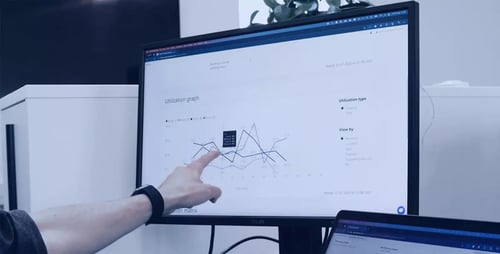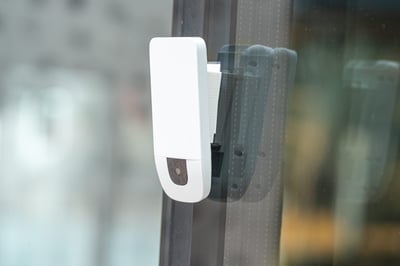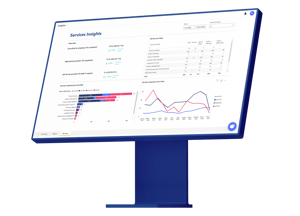You meet to share ideas, make progress, gain results, collaborate, learn, improve, and grow. These are why people end up in many meetings every week in a professional context.
Meetings are an integral part of business life. Your workforce’s meetings are at the heart of your organization. Meetings are where employees get together to collaborate and ultimately drive your company forward, possibly making them one of the most critical aspects of your office environment. A smart office design is built upon data gathered from meeting room insights to help employees work smarter, better, and faster.
Does conference room utilization represent your organization?
What happens in your conference rooms can tell you much about your company's processes and productivity. Unfortunately, keeping track of these subtle details is hard, which adds up and shows your entire company the bigger picture.
The best and most comprehensive meeting management software can help you systematically aggregate all your meeting data. Meeting room analytics tools in meeting management software let you track and measure important metrics related to your meetings. This information helps you plan for the future of your business and reduce the cost of meetings. That data is essential to understand your workplace consumption and utilization of your meeting rooms.
If you master your meeting room statistics, you can improve your strategies regarding everyday efficiency, workspace utilization, and optimal workplace design.
Understand your workspace utilization with meeting room analytics
Essential metrics to master include Occupancy, Time Score, Utilization Rates, and preferred "meeting room type."
By delving into the occupancy and usage rates of your meeting rooms, you gain valuable insights into which floors or departments in your organization are being utilized most frequently. This information is a goldmine for your real estate planning department. It equips them with data-driven decision-making capabilities when it comes to designing future office layouts and balancing the ratio between meeting rooms and desks/cubicles.

Using your meeting room analytics and data to measure the usage rates of your meeting rooms can reveal interesting patterns.
For instance, your analytics might reveal that the marketing department predominantly uses informal meeting spaces while the sales team prefers formal meeting rooms equipped with specific equipment and available services from IT, facility or catering.
You might also discover that certain meeting rooms experience peak utilization during specific times or seasons, suggesting the need for targeted scheduling adjustments or resource allocation.
Armed with this knowledge, you can strategically allocate resources and design your office layout to cater to these distinct preferences. This not only optimizes space but also enhances productivity by aligning your workspace with the needs of your different teams. Moreover, a data-driven approach ensures your meeting spaces are not just used but used effectively, ultimately leading to better workplace productivity and resource allocation.
Find patterns, learn habits, and find the suitable capacity
By leveraging your meeting management software to learn your meeting habits, you will quickly see how many people are invited to your meetings on average. Have many attended external meetings? How many participated in the weakly roundup?
Statistics from meeting room analytics suggest that most meetings contain 4 people or fewer. However, you might find that specific departments have a constant need for meetings of a more significant number, such as 8 or 12 people. Once you have this information, you can create a smart office design. If, for example, you find your meetings contain an average of 4 people, but all your meeting rooms are set out for at least 8 people, you will want to consider better utilization of these spaces, perhaps dividing these rooms into smaller ones.
 Conference rooms can include a variety of sensor technologies, like sensors from Internet of Things (IoT) or 'Bluetooth Low Energy"-Beacons (BLE), designed to track the attendance of individual members, for companies to gain insights about their meeting room usage on their premises. There are a lot of possibilities to include sensors and beacons as data sources, as they will improve your insights into meeting patterns even further.
Conference rooms can include a variety of sensor technologies, like sensors from Internet of Things (IoT) or 'Bluetooth Low Energy"-Beacons (BLE), designed to track the attendance of individual members, for companies to gain insights about their meeting room usage on their premises. There are a lot of possibilities to include sensors and beacons as data sources, as they will improve your insights into meeting patterns even further.
This data can give answer to the following question:
Is there a correlation between the number of meetings, specific meeting attendees, and your productivity score in your company?
Other features can include "meeting confirmation" or "claiming a room," which allows you to track if a meeting took place or if all attendees actually showed up at the meeting or conference room. Ghost meetings are a productivity killer for all companies. Knowing how many no-shows you have prevented gives you insights into how good (or bad) your team is at attending booked meetings. Accurate data allows your real estate planning team to make clear, concise decisions about your office space and how the layout is designed. Collecting meeting room analytics and data is an integral part of getting an overview of your office resources. It can help you create data-driven decisions about your future office layout.
Use meeting room analytics to leverage data and change behavior
A scheduling software can help you teach your team valuable lessons about meeting room culture. Meeting room analytics can be associated with an organizer and, over time, give you valuable insight into the different meeting techniques of your team members. In this way, meeting room analytics can help you leverage data and promoted your desired company behavior and culture.
By using meeting management software, with built-in analytics capabilities, you will get valuable insight into which team members plan and run their meetings efficiently. From there, you can create opportunities to inspire other team members who need it the most, ultimately driving up the efficiency of your entire team.
For example, you may find that some organizers book rooms with a capacity much larger than what they need. Based on your analytics, you can reach out to those team members, train them on how such a seemingly trivial issue can have a significant effect on cost and effectiveness of the company, and motivate them to improve booking behavior in the future.
By talking to your staff based on your data, you can also get to the bottom of why they plan meetings in sub optimal ways. You might find that the poor room utilization and bad booking behavior stems from a Facility Management-issue, e.g. small meeting rooms or huddle rooms are consistently busy, resulting in employees booking rooms with too high capacity for their needs.
Alternatively, you might find that it is because some rooms do not have the same features or lack the right in-room equipment. With this knowledge, you can equip your other rooms accordingly to stop this from happening in the future and lowering the time it takes to search for a fitting room. Your meeting room analytics can also help you track which team members are booking rooms for longer than needed, or what meetings are being extended. Are meetings being cut short? You might learn that your meeting displays lack a cancel option, or an option to prolong a meeting instead of going over time.
Take control of your meeting rooms
Thanks to new and comprehensive meeting management solutions, it is now easier than ever to track how your meeting rooms are being used, and your entire workspace is utilized. Whether you are concerned with real estate or the efficiency of your team, these metrics can help you make informed decisions about your company’s meeting rooms and plan accordingly for the future. Now you don't have to guess when people ask how many meetings you have each month or what your occupancy rates are.
These analytics tools are becoming more affordable and accessible as technology and software becomes more advanced. With cloud-based technologies, the best solutions integrate with your Exchange, Outlook, or Microsoft 365 calendar platform, meaning you have the possibility to "look back in time" and learn how your office space was being used before the implementation of a new meeting management platform.
Conclusion
The future of office design is data-driven. Embracing meeting room analytics and emerging technologies will create intelligent work spaces that cater to evolving needs. As businesses adopt this approach, the integration between workspace and worker will become more harmonious.
In conclusion, meeting room analytics is the key to unlocking the full potential of your workspace and improving productivity in your organization. By understanding the utilization rates, preferred meeting room types, and meeting habits of your team members, you can strategically allocate resources and design your office layout to cater to their distinct preferences.
Meeting management software with built-in analytics capabilities allows you to track and measure important metrics related to your meetings, enabling data-driven decision-making for future office layouts. Embracing meeting room analytics and emerging technologies will create intelligent workspaces that optimize space, enhance productivity, and ultimately drive your company forward.
Learn more about meeting room analytics and the future of smart office design.



